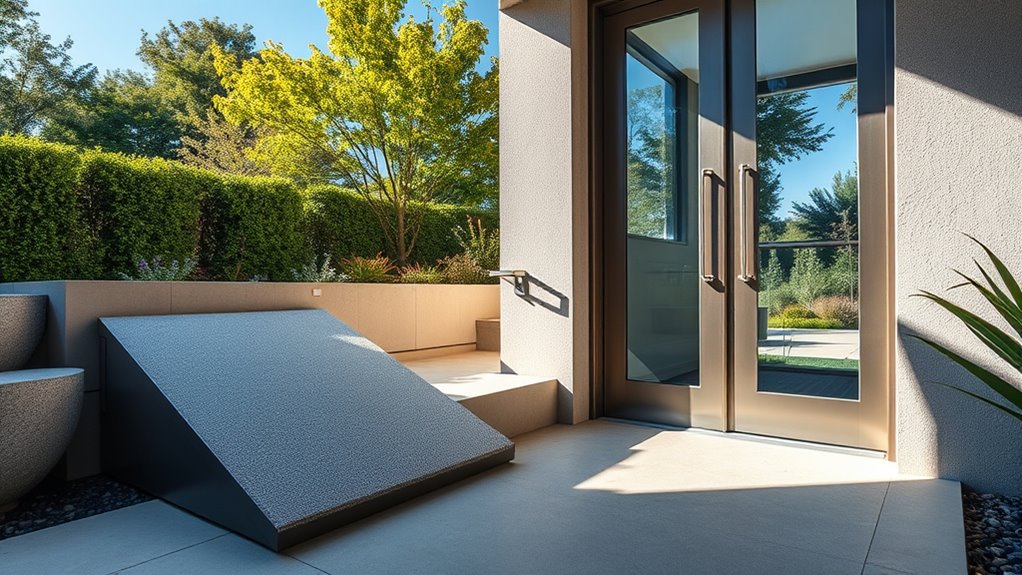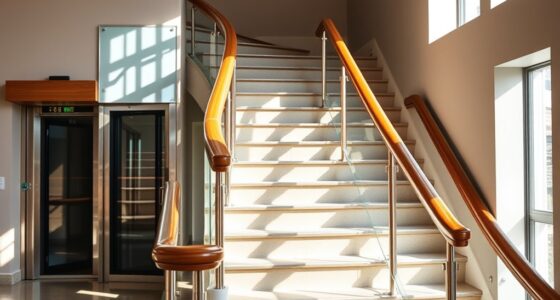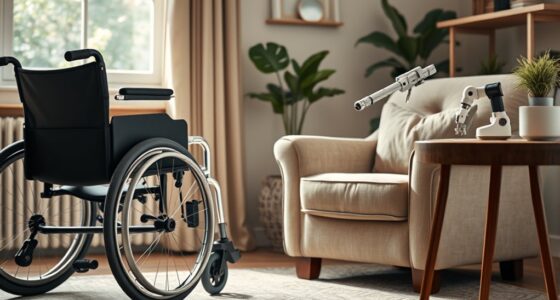Choosing between ramps and lifts depends on your home’s space, budget, and mobility needs. Ramps are affordable and work well outdoors, but they require significant outdoor space and proper slope considerations. Lifts are compact, ideal for tight areas, and provide a secure, weather-protected option, but they cost more upfront. To make an informed decision tailored to your situation, continue exploring the key differences and advantages of each solution.
Key Takeaways
- Ramps are cost-effective and suitable for outdoor use, but require significant space and longer installation time.
- Lifts occupy minimal space and offer safer, controlled vertical movement, ideal for confined or indoor environments.
- Ramps are easier to install temporarily and are more adaptable for short-term needs or outdoor accessibility.
- Lifts provide enhanced safety features and comfort for users with significant mobility challenges.
- Long-term, lifts often have higher initial costs but lower maintenance and ongoing expenses, making them more cost-efficient over time.
Understanding the Basics of Wheelchair Accessibility Solutions
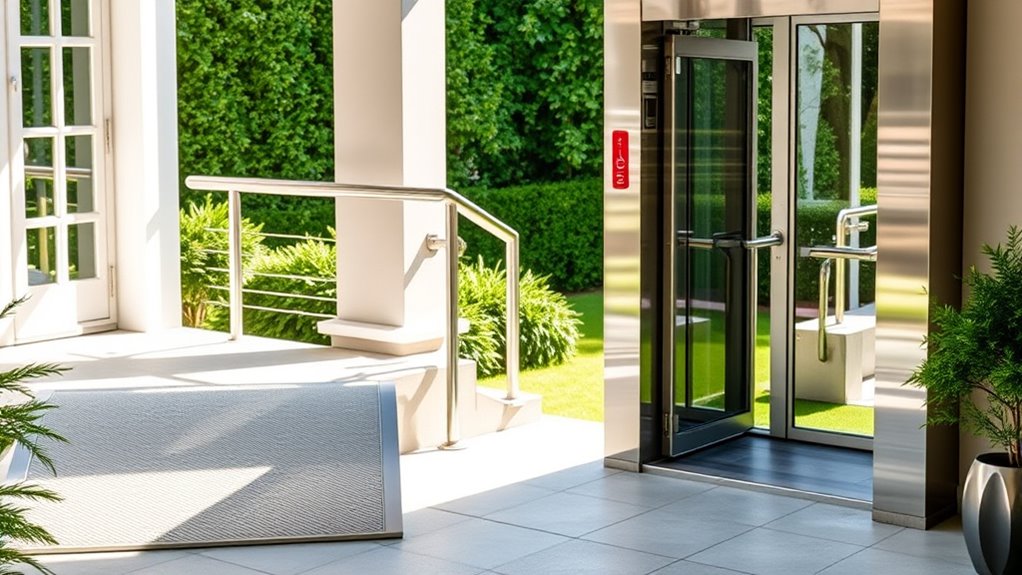
Wheelchair accessibility solutions are designed to remove barriers and provide safe, convenient passage for users with mobility challenges.
Wheelchair accessibility solutions ensure safe, barrier-free passage for users with mobility challenges.
Wheelchair ramps are inclined surfaces built with a gentle slope, usually 1:12, to easily navigate stairs or uneven terrain. They can be made from materials like aluminum, wood, or concrete, and their length varies depending on the height they need to cover.
Vertical platform lifts are motorized devices that lift users vertically between levels, resembling small elevators, making them ideal when space or terrain makes ramps impractical.
Both mobility solutions aim to eliminate obstacles, but choosing between them depends on factors like available space, mobility needs, and budget.
Considering digital literacy programs can help seniors effectively use these accessibility solutions and other assistive technologies, enhancing independence and safety at home.
Additionally, understanding proper installation and maintenance requirements for these options is essential to ensure safety, longevity, and optimal performance.
Understanding these options helps you determine the best accessibility solution for your home.
Additionally, considering air quality can enhance the overall safety and comfort of your living environment, especially for individuals with mobility challenges who may spend more time indoors.
Comparing Costs and Long-Term Investment
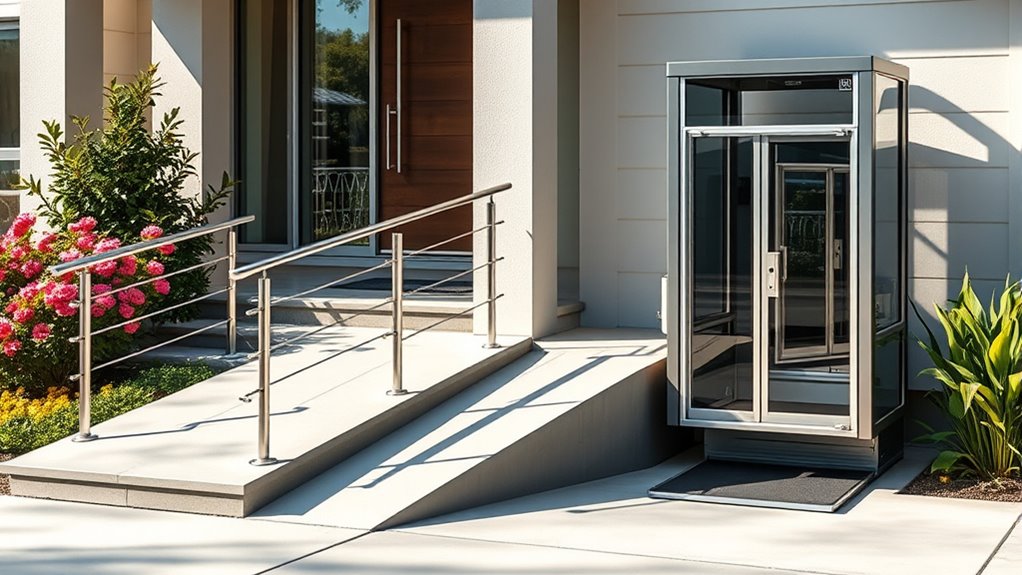
When evaluating accessibility solutions, understanding the costs and long-term investment involved is essential. Ramps usually have a lower initial cost but can become more expensive over time due to their space needs and potential site modifications. Additionally, choosing the right option depends on the specific needs and space constraints of the property. Wheelchair lifts require a higher upfront expense but often prove more cost-effective in the long run by reducing installation, maintenance, and space-related costs. The total cost of a ramp increases with its length, especially for taller stairs, making lifts a more economical choice in limited spaces. Renting ramps can cut initial costs for temporary needs, but lifts are typically purchased because of their permanent installation. Moreover, space efficiency is a key factor to consider, as lifts often require less room than ramps in confined areas. Incorporating cost-effective mobility solutions can further optimize accessibility investments. For example, understanding the long-term durability of different options can help in making a more informed decision. Additionally, considering the asset division process in property-related decisions can provide valuable insights into planning for future needs. Overall, lifts often offer better long-term value in tight spaces, while ramps may be more cost-efficient for short-term or temporary solutions. Considering essential oils for mobility support can also be beneficial for individuals with accessibility needs.
Space Requirements and Site Planning Considerations
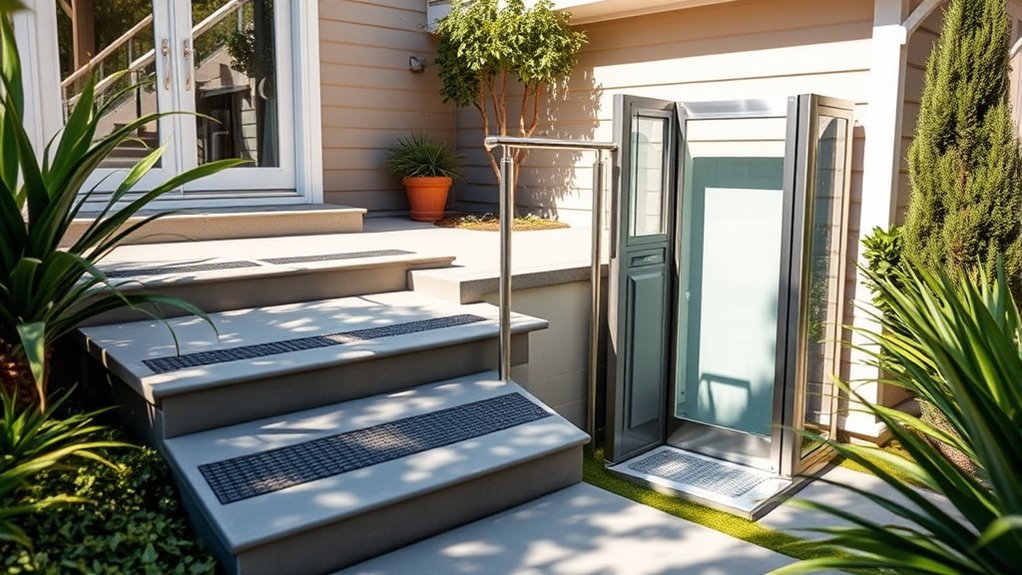
When planning for accessibility, you need to contemplate how much space ramps and lifts will require. Ramps often need significant outdoor room due to their slope ratio, while lifts fit into tight areas like garages or porches. Choosing the right option depends on balancing site layout constraints with available space. Additionally, considering the best laundry detergents can be helpful for maintaining cleanliness in accessible spaces. Proper site planning also involves assessing growth and harvesting chia seeds to ensure any garden or planting areas do not interfere with accessibility features. It’s also important to understand that airtight coolers can improve insulation and help maintain temperature control during outdoor accessibility projects.
Space Needed for Ramps
Because ramps require a gentle slope of 1:12 to guarantee safety, you need to plan for a significant amount of space, especially for higher elevations. If your home has limited space, fitting a ramp can be challenging. Imagine these considerations:
- A 7-step rise of 56 inches needs roughly 56 feet of ramp length.
- You’ll require extra space for landings and turns.
- Narrow properties may find it difficult to accommodate long ramps.
- Steeper ramps above 1:8 slope are discouraged, reducing usable options.
- Proper site planning is essential to optimize available space and ensure safety. Additionally, considering space efficiency can help maximize the usability of your available area without sacrificing safety. Implementing automation tools for design planning can streamline the process, especially in complex layouts. Ensuring compliance with building codes is also crucial to avoid future legal issues and guarantee safety. A thorough understanding of local regulations can prevent costly modifications later on.
In tight spaces, a traditional ramp mightn’t be practical, making it essential to assess your available area carefully before planning. Proper site planning ensures safety and functionality without compromising your home’s layout.
Compactness of Lifts
Unlike ramps, which require extensive space for gentle slopes and landings, lifts offer a compact alternative that fits into tight areas. They need minimal space—around 5 by 5 feet—for installation, making them ideal for small or confined spots. A lift’s space efficiency can significantly reduce construction costs and time compared to building new ramps. Because lifts don’t rely on long pathways or slopes, they conserve valuable space in your home or yard. With a lifting height of up to 14 feet, they efficiently maximize vertical space without expanding your footprint horizontally. Their small footprint allows installation in areas like garages, porches, or narrow outdoor pathways. Additionally, the installation process for lifts is often quicker and less invasive than constructing a ramp, further saving time and resources. The cost-effectiveness of lifts can be a major advantage for homeowners looking to improve accessibility without extensive remodeling. Furthermore, selecting a lift with safety features ensures reliable operation and peace of mind during use. While site planning must consider structural support and clearance, overall, lifts occupy considerably less space than traditional ramps, making them a practical, space-efficient solution for homes with limited room. Permits and inspections may be required to ensure proper installation and compliance with local building codes.
Site Layout Planning
Effective site layout planning depends on understanding the space requirements of ramps and lifts. Ramps need a slope of 1:12, making their length and space considerations significant, especially with more steps. For example, a 7-step staircase may require about 50 feet of ramp to meet accessibility solutions. Additionally, cost considerations can influence the choice between ramps and lifts, as long-term maintenance and installation expenses vary. Proper planning also involves evaluating installation complexity, which can differ significantly between the two options. Conversely, vertical platform lifts occupy minimal space, around 5 x 5 feet, ideal for limited-site areas. When planning your site layout, consider existing structures, available indoor or outdoor space, and future accessibility needs. Ramps can be configured in various layouts to fit different site constraints, but they’re more space-intensive. Additionally, understanding the Gold IRA options available can influence long-term planning for accessible retirement investments, emphasizing the importance of strategic investment diversification. Lifts, though compact, are better suited for tight or complex spaces. Proper site planning ensures your accessibility solutions are both functional and space-efficient.
Assessing User Mobility and Safety Features
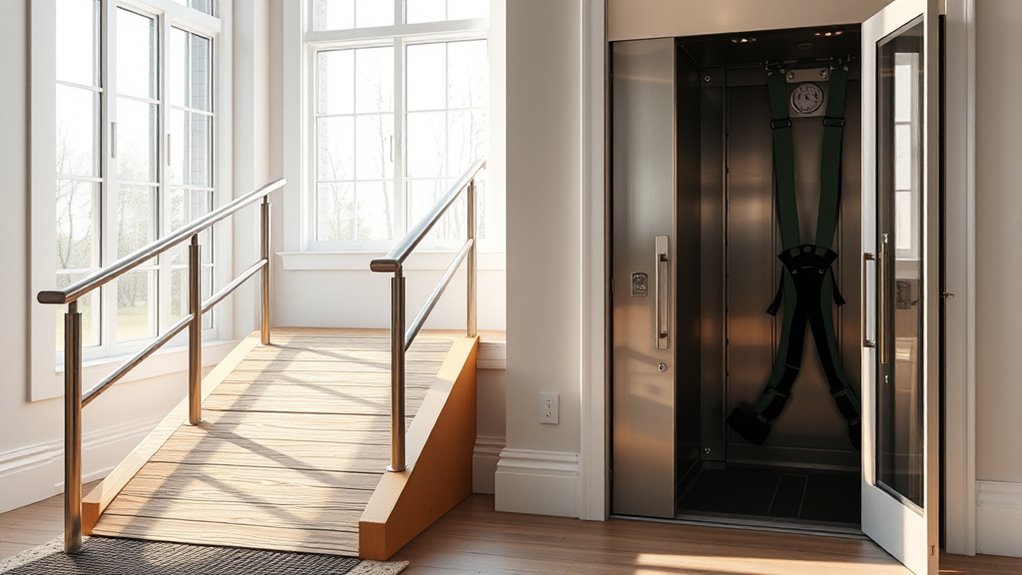
When choosing between ramps and lifts, you need to consider user comfort and how easy each option is to use. Safety features like mechanical safeguards and non-slip surfaces are vital for preventing accidents. Incorporating security measures such as surveillance cameras or motion detectors can also enhance safety in your home environment.
User Comfort and Ease
User comfort and ease of use largely depend on how well the mobility devices accommodate individual needs and safety features. With a lift, you benefit from a controlled vertical move that requires minimal effort, making it more comfortable for those with limited strength.
A lift often incorporates safety features such as sensors and automatic brakes, which enhance confidence during operation. Ramps demand traversing a gradual slope, which can be taxing if you have balance or mobility issues. Visualize:
- Using a lift with simple controls that you can operate effortlessly.
- Feeling secure with safety bars and sensors that prevent accidents.
- Moving smoothly with automatic brakes engaging when needed.
- Walking or transferring confidently onto a ramp with non-slip surfaces for added safety.
Both devices aim to enhance user comfort and ease of operation, but lifts generally provide a safer, more secure experience, especially for users with significant mobility challenges.
Safety and Mechanical Safeguards
Safety and mechanical safeguards are essential in ensuring that mobility devices protect users during operation. Safety features like obstacle detection, emergency stop buttons, and safety sensors are built into wheelchair lifts to prevent accidents and enhance user protection.
Vertical platform lifts often include safety enclosures and interlock systems that prevent movement unless gates are securely closed, safeguarding users. Ramps, while relying more on user awareness, incorporate anti-slip surfaces and handrails to promote safety; however, they lack automatic safety mechanisms.
User mobility levels significantly influence safety considerations, as lifts are designed to accommodate users with limited strength or dexterity through mechanical safeguards that ramps alone can’t provide.
Proper installation by certified professionals ensures safety features are correctly implemented, reducing risks and ensuring reliable user protection.
Installation Processes and Timeframes

Installing ramps typically takes just a few hours to a day, thanks to their straightforward design and simple assembly methods. You’ll likely move through these steps quickly:
- Clear the area where the ramp will go
- Prepare the surface, often leveling it for stability
- Assemble modular components or install the concrete pad if needed
- Secure the ramp and perform a quick safety check
This streamlined process means minimal disruption.
In contrast, lifts require more time, often one to two days, because they need a concrete pad, electrical wiring, and precise alignment. The installation of lifts involves safety inspections and compliance checks, adding to the timeframe.
Durability, Maintenance, and Material Options

When choosing between ramps and lifts, considering their durability and maintenance needs is important to guarantee long-term performance. Aluminum ramps are rust-resistant, require little upkeep, and typically last 10-15 years with proper care.
Steel and concrete ramps are more durable but may need periodic treatments to prevent corrosion or cracking. Wheelchair lifts, especially electric models, require regular inspections and occasional mechanical servicing to ensure safety and reliable operation.
Material options like composite or vinyl-coated surfaces enhance slip resistance and reduce maintenance over time. Proper upkeep—cleaning and routine inspections—extends their lifespan and keeps safety standards intact.
Flexibility and Adaptability for Changing Needs
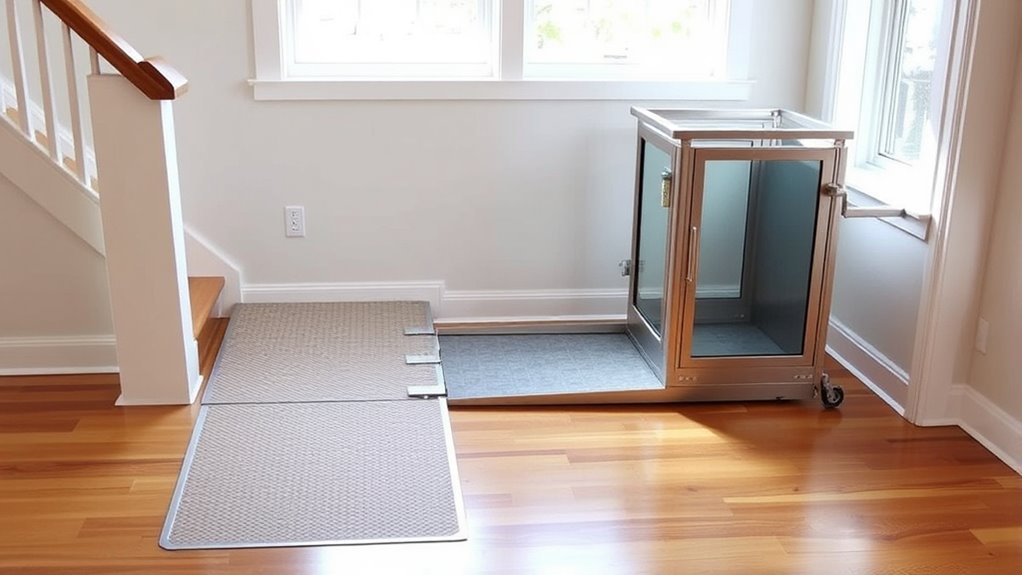
Choosing between ramps and lifts often depends on how easily your accessibility solutions can adapt to changing needs. Modular ramps can be extended or reconfigured with ease, allowing you to:
- Add sections for longer distances
- Adjust for different user requirements
- Reposition or redesign to save space
- Upgrade with new technology or capacity features
Similarly, modular wheelchair lifts can be removed or relocated if your mobility needs change or if you plan to sell your home. Both options offer customizable features like handrails and control options, enhancing flexibility as your strength or dexterity evolves.
Investing in adaptable, modular solutions ensures your accessibility setup remains functional and effective, even as your needs shift over time. This adaptability provides peace of mind, knowing your home can grow with you.
Environmental Factors and Weather Protection
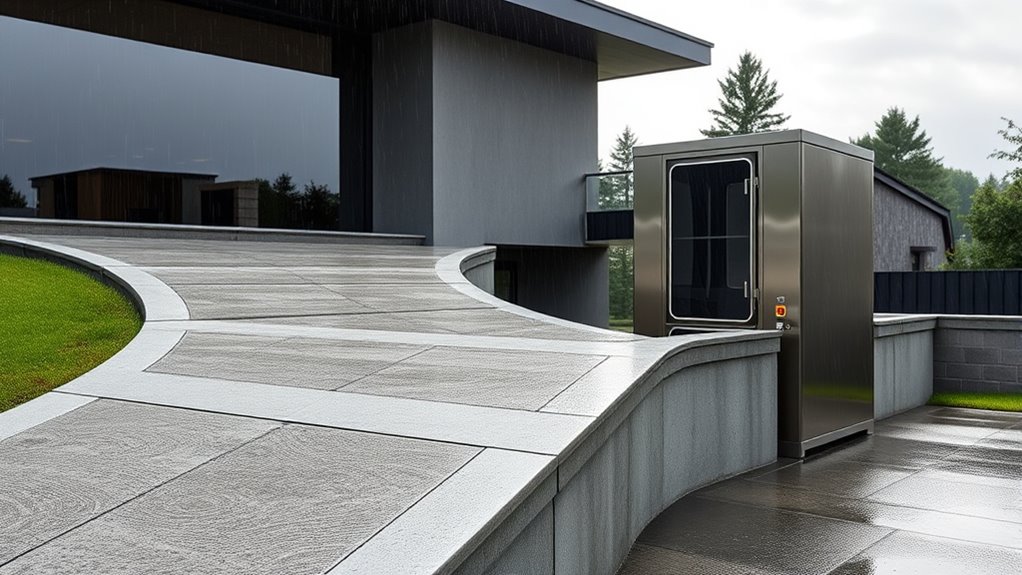
Outdoor ramps are vulnerable to weather conditions, which can compromise safety and increase maintenance needs. Exposure to rain, snow, and ice can make ramps slippery and hazardous. Proper weather protection, like anti-slip surfaces and regular upkeep, helps reduce accidents caused by wet or icy conditions.
However, outdoor use of ramps often requires ongoing maintenance to prevent rust, warping, or deterioration from moisture exposure. In contrast, wheelchair lifts installed in garages offer better weather-resistant features, shielding users from the elements and ensuring safer operation in harsh weather.
Vertical platform lifts are also designed with weather-resistant materials and protective enclosures, making them suitable for outdoor use in extreme climates. Overall, weather protection is a key factor when choosing between ramps and lifts for outdoor accessibility.
Making the Best Choice for Your Home and Lifestyle
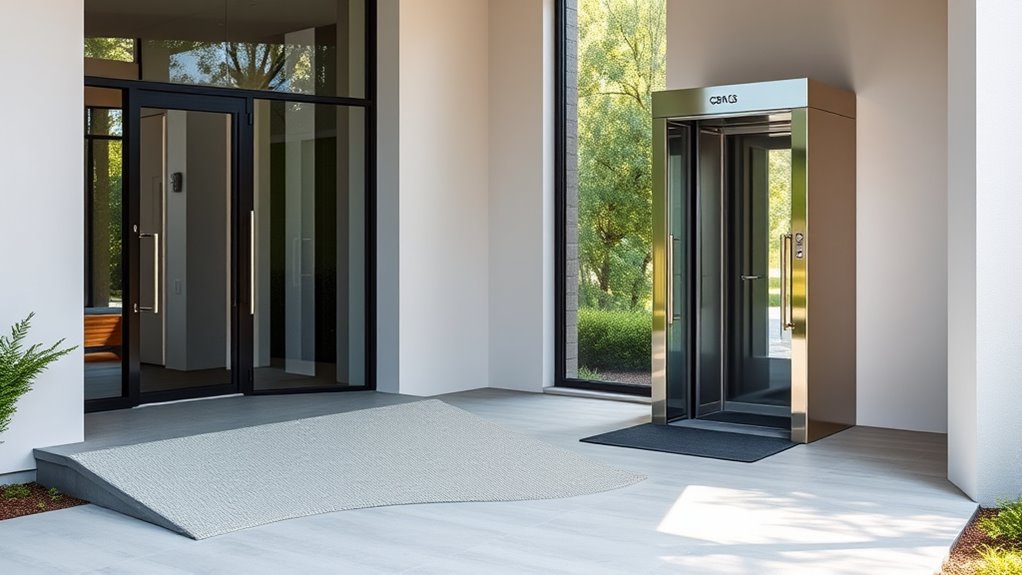
Deciding between a ramp and a lift depends largely on your available space, budget, and mobility needs.
Choosing between a ramp and a lift depends on your space, budget, and mobility requirements.
If space is limited, a lift offers a compact solution—just 5×5 feet—while ramps need a longer stretch, like 50 feet for seven steps.
Your budget also plays a role: ramps are usually less costly upfront, but lifts can save space and add convenience.
Consider your mobility level: ramps work well if you can manage slopes, but lifts are better for significant mobility challenges.
Think about safety and environment: lifts often provide weather protection and are installed indoors, while ramps suit outdoor pathways.
Consulting with accessibility professionals helps ensure your choice aligns with your home’s layout and your lifestyle, maximizing accessibility and ease of use.
Frequently Asked Questions
Does a Ramp Increase Home Value?
You might wonder if adding a ramp increases your home’s value. Generally, a well-built, ADA-compliant ramp can boost curb appeal and show your commitment to accessibility, which many buyers find attractive.
While it may not drastically raise your home’s price, it can make your property more appealing to buyers with mobility needs. Keep in mind, the actual impact depends on your local market, the quality of the ramp, and buyer preferences.
What Are the Disadvantages of Wheelchair Ramps?
Imagine a world where wheelchair ramps dominate your home’s landscape, only to reveal their inconvenient truths. You’ll find that ramps demand massive space, often turning your yard into a sprawling obstacle course.
They can be costly to build and maintain, especially if you want safety standards. Slippery when wet, they risk turning your smooth access into a dangerous slip-and-fall zone.
Sometimes, ramps just aren’t the practical hero you imagined.
Are Ramps Better Than Stairs for the Elderly?
You might find ramps better than stairs for the elderly because they offer a gentle incline that’s easier and safer to navigate. Ramps reduce fall risks, don’t require lifting, and can accommodate mobility aids like walkers and scooters.
Plus, they’re customizable to meet specific needs, providing comfort and independence. Overall, ramps promote safer, more accessible movement, making them a practical choice for elderly individuals in your home.
What Are the Disadvantages of Platform Lifts?
You should know that platform lifts can be expensive to buy and install, often costing more than ramps. They need a solid foundation, which can add to costs and complexity.
Their limited travel makes them unsuitable for long distances, and mechanical parts may need regular maintenance.
Additionally, some users might find controls hard to reach, reducing accessibility for certain individuals with mobility challenges.
Conclusion
Ultimately, choosing between ramps and lifts depends on your unique needs and home layout. Think of it like choosing between a trusty steed and a flying chariot—each has its strengths. Consider safety, space, and long-term use to make the best decision. With today’s options, you’ll find solutions that blend function and style, ensuring your home remains accessible and welcoming. After all, your comfort and independence are worth the effort—like a modern-day knight safeguarding your castle.
